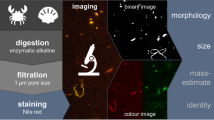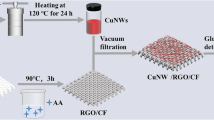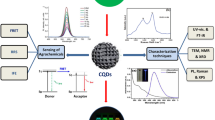Abstract
Herein, an electrochemical biosensor based on carbon nanofibers (CNF) and ferrocene carboxylic acid (FcA) modified glassy carbon electrode (GCE) was fabricated for xanthine determination. Xanthine oxidase (XO) was further immobilized onto the FcA/CNF/GCE for the fabrication of the biosensor. The morphologic appearance of the XO/FcA/CNF/GCE was studied by scanning electron microscopy (SEM) and energy-dispersive X-ray spectroscopy (EDX). Electrochemical impedance spectroscopy (EIS) and cyclic voltammetry (CV) measurements were also performed to determine the electrochemical characteristics of the modified electrode. The XO/FcA/CNF/GCE biosensor exhibited linear response for xanthine in the concentration range of 6.0 × 10–7 to 2.0 × 10–4 M with a sensitivity of 6.04 µAmM−1 and a detection limit of 1.7 × 10–7 M. The xanthine biosensor also exhibited the advantages of high reproducibility, anti-interference ability and good long-term stability. Furthermore, the XO/FcA/CNF/GCE was used for the determination of xanthine in fish meat and the satisfactory results indicated that the FcA/CNF matrix is a promising candidate for electrode modification.









Similar content being viewed by others
Data Availability
No datasets were generated or analysed during the current study.
References
Devi R, Thakur M, Pundir CS (2011) Construction and application of an amperometric xanthine biosensor based on zinc oxide nanoparticles–polypyrrole composite film. Biosens Bioelectron 26(8):3420–3426. https://doi.org/10.1016/j.bios.2011.01.014
Pundir CS, Devi R (2014) Biosensing methods for xanthine determination: A review. Enzyme Microb 57:55–62. https://doi.org/10.1016/j.enzmictec.2013.12.006
Venugopal V (2002) Biosensors in fish production and quality control. Biosens Bioelectron 17(3):147–157. https://doi.org/10.1016/S0956-5663(01)00180-4
Dalkiran B, Kacar C, Erden PE, Kilic E (2014) Amperometric xanthine biosensors based on chitosan-Co3O4-multiwall carbon nanotube modified glassy carbon electrode. Sens Actuators B: Chem 200:83–91. https://doi.org/10.1016/j.snb.2014.04.025
Amigo JM, Coello J, Maspoch S (2005) Three-way partial least-squares regression for the simultaneous kinetic-enzymatic determination of xanthine and hypoxanthine in human urine. Anal Bioanal Chem 382:1380–1388. https://doi.org/10.1007/s00216-005-3275-4
Cooper N, Khosravan R, Erdmann C, Fiene J, Lee JW (2006) Quantification of uric acid, xanthine and hypoxanthine in human serum by HPLC for pharmacodynamic studies. J Chromatogr B 837(1–2):1–10. https://doi.org/10.1016/j.jchromb.2006.02.060
Hlavay J, Haemmerli SD, Guilbault GG (1994) Fibre-optic biosensor for hypoxanthine and xanthine based on a chemiluminescence reaction. Biosens Bioelectron 9(3):189–195. https://doi.org/10.1016/0956-5663(94)80121-5
Caussé E, Pradelles A, Dirat B, Negre-Salvayre A, Salvayre R, Couderc F (2007) Simultaneous determination of allantoin, hypoxanthine, xanthine, and uric acid in serum/plasma by CE. Electrophoresis 28(3):381–387. https://doi.org/10.1002/elps.200600205
Pagliarussi RS, Freitas LA, Bastos JK (2002) A quantitative method for the analysis of xanthine alkaloids in Paullinia cupana (guarana) by capillary column gas chromatography. J Sep Sci 25(5–6):371–374. https://doi.org/10.1002/1615-9314(20020401)25:5/6%3c371::AID-JSSC371%3e3.0.CO;2-9
Dalkıran B, Erden PE, Kılıç E (2017) Amperometric biosensors based on carboxylated multiwalled carbon nanotubes-metal oxide nanoparticles-7, 7, 8, 8-tetracyanoquinodimethane composite for the determination of xanthine. Talanta 167:286–295. https://doi.org/10.1016/j.talanta.2017.02.021
Yazdanparast S, Benvidi A, Abbasi S, Rezaeinasab M (2019) Enzyme-based ultrasensitive electrochemical biosensor using poly (L-aspartic acid)/MWCNT bio-nanocomposite for xanthine detection: A meat freshness marker. Microchem J 149:104000. https://doi.org/10.1016/j.microc.2019.104000
Wang Z, Ma B, Shen C, Lai OM, Tan CP, Cheong LZ (2019) Electrochemical biosensing of chilled seafood freshness by xanthine oxidase immobilized on copper-based metal–organic framework nanofiber film. Food Anal Methods 12:1715–1724. https://doi.org/10.1007/s12161-019-01513-8
Alam MM, Asiri AM, Uddin MT, Islam MA, Rahman MM (2018) Wet-chemically prepared low-dimensional ZnO/Al2O3/Cr2O3 nanoparticles for xanthine sensor development using an electrochemical method. RSC Adv 8(23):12562–12572. https://doi.org/10.1039/c8ra01734d
Rahman MM, Balkhoyor HB, Asiri AM (2017) Ultra-sensitive xanthine sensor development based on wet-chemically prepared Co/ZnO nanoparticles. Mater Express 7(2):93–103. https://doi.org/10.1166/mex.2017.1356
Adhikari BR, Govindhan M, Chen A (2015) Carbon nanomaterials based electrochemical sensors/biosensors for the sensitive detection of pharmaceutical and biological compounds. Sensors 15(9):22490–22508. https://doi.org/10.3390/s150922490
Lu X, Zhou J, Lu W, Liu Q, Li J (2008) Carbon nanofiber-based composites for the construction of mediator-free biosensors. Biosens Bioelectron 23(8):1236–1243. https://doi.org/10.1016/j.bios.2007.11.006
Huang J, Liu Y, You T (2010) Carbon nanofiber based electrochemical biosensors: A review. Anal Methods 2(3):202–211. https://doi.org/10.1039/B9AY00312F
Wang WQ, Yue HY, Yu ZM, Huang S, Song SS, Gao X, Guan EH, Zhang HJ, Wang Z (2019) Synthesis of graphene/carbon nanofiber for electrochemical determination of levodopa in the presence of uric acid. Ionics 25:2835–2843. https://doi.org/10.1007/s11581-018-2801-2
Kaçar C, Erden PE (2020) An amperometric biosensor based on poly (L-aspartic acid), nanodiamond particles, carbon nanofiber, and ascorbate oxidase–modified glassy carbon electrode for the determination of L-ascorbic acid. Anal Bioanal Chem 412:5315–5327. https://doi.org/10.1007/s00216-020-02747-w
Hoshi T, Noguchi T, Anzai JI (2006) The preparation of amperometric xanthine sensors based on multilayer thin films containing xanthine oxidase. Mater Sci Eng C 26(1):100–103. https://doi.org/10.1016/j.msec.2005.06.001
Turner AP (1988) Amperometric biosensors based on mediator-modified electrodes. Methods Enzymol 137:90–103. https://doi.org/10.1016/0076-6879(88)37009-6
Baş SZ, Gülce H, Yıldız S (2011) Amperometric xanthine biosensors based on electrodeposition of platinum on polyvinylferrocenium coated Pt electrode. J Mol Catal 72(3–4):282–288. https://doi.org/10.1016/j.molcatb.2011.06.017
Guven N, Apetrei RM, Camurlu P (2021) Next step in 2nd generation glucose biosensors: Ferrocene-loaded electrospun nanofibers. Mater Sci Eng C 128:112270. https://doi.org/10.1016/j.msec.2021.112270
Cass AEG, Davis G, Francis GD, Hill HAO, Aston WJ, Higgins IJ, Plotkin EV, Scott LDL, Turner AP (1984) Ferrocene-mediated enzyme electrode for amperometric determination of glucose. Anal Chem 56(4):667–671. https://doi.org/10.1021/ac00268a018
Erden PE, Selvi CK, Kılıç E (2021) A novel tyramine biosensor based on carbon nanofibers, 1-butyl-3-methylimidazolium tetrafluoroborate and gold nanoparticles. Microchem J 170:106729. https://doi.org/10.1016/j.microc.2021.106729
Mahmoudifard M, Soudi S, Soleimani M, Hosseinzadeh S, Esmaeili E, Vossoughi M (2016) Efficient protein immobilization on polyethersolfone electrospun nanofibrous membrane via covalent binding for biosensing applications. Mater Sci Eng C 58:586–594. https://doi.org/10.1016/j.msec.2015.09.007
Noah NM, Omole M, Stern S, Zhang S, Sadik OA, Hess EH, Martinovic J, Baker PGL, Iwuoha EI (2012) Conducting polyamic acid membranes for sensing and site-directed immobilization of proteins. Anal Biochem 428(1):54–63. https://doi.org/10.1016/j.ab.2012.06.008
Shahbazmohammadi H, Sardari S, Omidinia E (2020) An amperometric biosensor for specific detection of glycated hemoglobin based on recombinant engineered fructosyl peptide oxidase. Int J Biol Macromol 142:855–865. https://doi.org/10.1016/j.ijbiomac.2019.10.025
Bard AJ, Faulkner LR (2001) Electrochemical methods, Fundamentals and Applications, 2nd edn. John Wiley & Sons Inc, New York
Lv J, Li C, Feng S, Chen SM, Ding Y, Chen C, Hao Q, Yang TH, Lei W (2019) A novel electrochemical sensor for uric acid detection based on PCN/MWCNT. Ionics 25:4437–4445. https://doi.org/10.1007/s11581-019-03010-8
Devi R, Yadav S, Pundir CS (2011) Electrochemical detection of xanthine in fish meat by xanthine oxidase immobilized on carboxylated multiwalled carbon nanotubes/polyaniline composite film. Biochem Eng J 58:148–153. https://doi.org/10.1016/j.bej.2011.09.008
Deepa S, Swamy BK, Pai KV (2020) A surfactant SDS modified carbon paste electrode as an enhanced and effective electrochemical sensor for the determination of doxorubicin and dacarbazine its applications: A voltammetric study. J Electroanal Chem 879:114748. https://doi.org/10.1016/j.jelechem.2020.114748
Kumar M, Swamy BK, Sravanthi C, Kumar CP, Jayaprakash GK (2022) NiFe2O4 nanoparticle modified electrochemical sensor for the voltammetric study of folic acid and paracetamol. Mater Chem Phys 284:126087. https://doi.org/10.1016/j.matchemphys.2022.126087
Wang Y, Li C, Wu T, Ye X (2018) Polymerized ionic liquid functionalized graphene oxide nanosheets as a sensitive platform for bisphenol A sensing. Carbon 129:21–28. https://doi.org/10.1016/j.carbon.2017.11.090
Kanyong P, Rawlinson S, Davis J (2016) A non-enzymatic sensor based on the redox of ferrocene carboxylic acid on ionic liquid film-modified screen-printed graphite electrode for the analysis of hydrogen peroxide residues in milk. J Electroanal Chem 766:147–151. https://doi.org/10.1016/j.jelechem.2016.02.006
Sassolas A, Blum LJ, Leca-Bouvier BD (2012) Immobilization strategies to develop enzymatic biosensors. Biotechnol Adv 30(3):489–511. https://doi.org/10.1016/j.biotechadv.2011.09.003
Balladin DA, Narinesingh D, Stoute VA, Ngo TT (1997) Immobilization of xanthine oxidase and its use in the quantitation of hypoxanthine in fish muscle tissue extracts using a flow injection method. Appl Biochem Biotechnol 62:317–328
Sigurdardóttir SB, Lehmann J, Ovtar S, Grivel JC, Negra MD, Kaiser A, Pinelo M (2018) Enzyme immobilization on inorganic surfaces for membrane reactor applications: mass transfer challenges, enzyme leakage and reuse of materials. Adv Synth Catal 360(14):2578–2607. https://doi.org/10.1002/adsc.201800307
Dalkıran B, Erden PE, Kılıç E (2017) Construction of an electrochemical xanthine biosensor based on graphene/cobalt oxide nanoparticles/chitosan composite for fish freshness detection. JOTCSA 4(1):23–44. https://doi.org/10.18596/jotcsa.54485
Joon A, Ahlawat J, Aggarwal V, Jaiwal R, Pundir CS (2021) An improved amperometric determination of xanthine with xanthine oxidase nanoparticles for testing of fish meat freshness. Sens Bio-Sens Res 33:100437. https://doi.org/10.1016/j.sbsr.2021.100437
Saadaoui M, Sánchez A, Díez P, Raouafi N, Pingarrón JM, Villalonga R (2016) Amperometric xanthine biosensors using glassy carbon electrodes modified with electrografted porous silica nanomaterials loaded with xanthine oxidase. Microchim Acta 183:2023–2030. https://doi.org/10.1007/s00604-016-1840-5
Sahyar BY, Kaplan M, Ozsoz M, Celik E, Otles S (2019) Electrochemical xanthine detection by enzymatic method based on Ag doped ZnO nanoparticles by using polypyrrole. Bioelectrochemistry 130:107327. https://doi.org/10.1016/j.bioelechem.2019.107327
Çevik S (2016) Xanthine biosensor based on XO/AuNP/PtNP/MWCNT hybrid nanocomposite modified GCPE. Biotechnol and Bioprocess Eng 21:314–320. https://doi.org/10.1007/s12257-016-0014-y
Dervisevic M, Custiuc E, Çevik E, Şenel M (2015) Construction of novel xanthine biosensor by using polymeric mediator/MWCNT nanocomposite layer for fish freshness detection. Food Chem 181:277–283. https://doi.org/10.1016/j.foodchem.2015.02.104
Thakur D, Pandey CM, Kumar D (2022) Highly sensitive enzymatic biosensor based on polyaniline-wrapped titanium dioxide nanohybrid for fish freshness detection. Appl Biochem Biotechnol 194(8):3765–3778. https://doi.org/10.1007/s12010-022-03931-7
Öztürk FÖ, Erden PE, Kaçar C, Kiliç E (2014) Amperometric Biosensor for Xanthine Determination Based on Fe3O4 Nanoparticles. Acta Chim Slov 61(1):19–26
Funding
This study was supported by Ankara University Scientific Research Projects Coordination Unit (Project No: 21L0430019).
Author information
Authors and Affiliations
Contributions
E.C. Performed the analysis, created figures
C.K.S. Conceived and designed the analysis, analyzed data
E.C. Supervised the work
P.E.E. Wrote the paper, analyzed data
E.K. Reviewed and edited the paper
All authors reviewed the manuscript.
Corresponding author
Ethics declarations
Competing interests
The authors declare no competing interests.
Additional information
Publisher's Note
Springer Nature remains neutral with regard to jurisdictional claims in published maps and institutional affiliations.
Rights and permissions
Springer Nature or its licensor (e.g. a society or other partner) holds exclusive rights to this article under a publishing agreement with the author(s) or other rightsholder(s); author self-archiving of the accepted manuscript version of this article is solely governed by the terms of such publishing agreement and applicable law.
About this article
Cite this article
Can, E., Kaçar Selvi, C., Canel, E. et al. Electrochemical xanthine biosensor based on carbon nanofiber and ferrocene carboxylic acid for the assessment of fish freshness. Ionics (2024). https://doi.org/10.1007/s11581-024-05575-5
Received:
Revised:
Accepted:
Published:
DOI: https://doi.org/10.1007/s11581-024-05575-5




